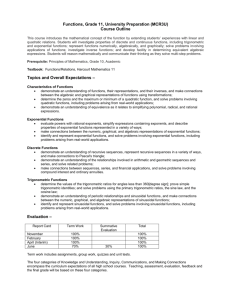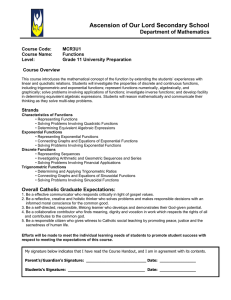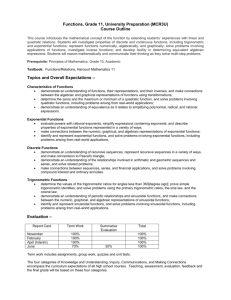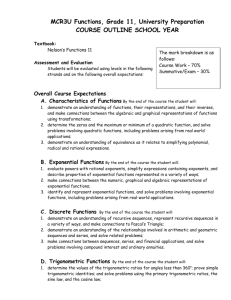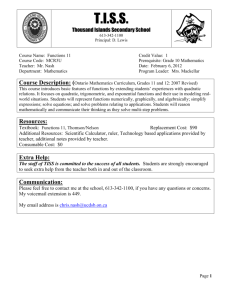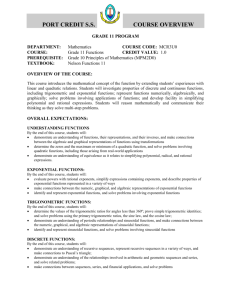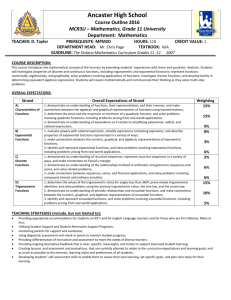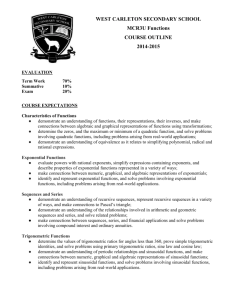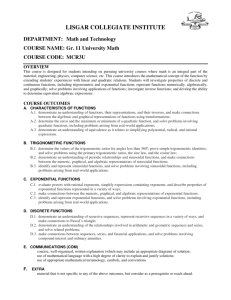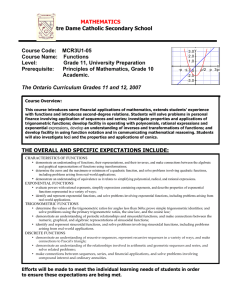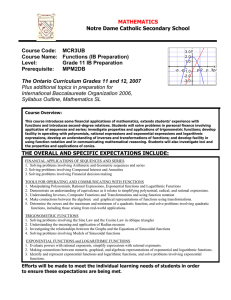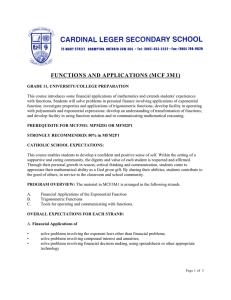MATHEMATICS DEPARTMENT
advertisement
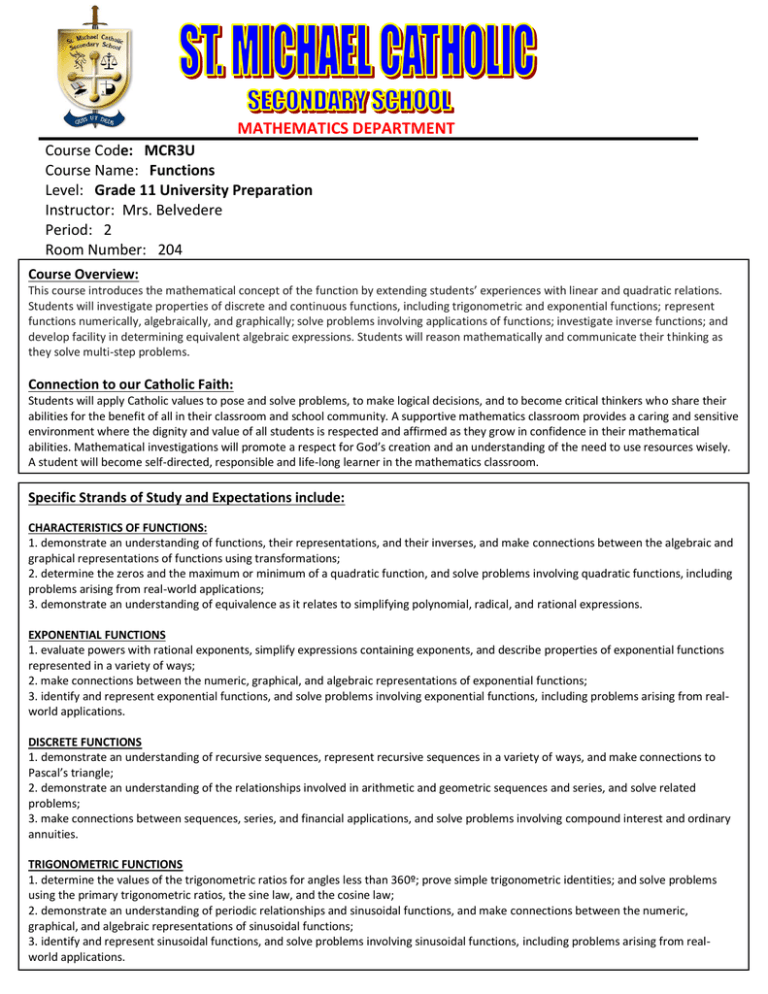
MATHEMATICS DEPARTMENT Course Code: MCR3U Course Name: Functions Level: Grade 11 University Preparation Instructor: Mrs. Belvedere Period: 2 Room Number: 204 Course Overview: This course introduces the mathematical concept of the function by extending students’ experiences with linear and quadratic relations. Students will investigate properties of discrete and continuous functions, including trigonometric and exponential functions; represent functions numerically, algebraically, and graphically; solve problems involving applications of functions; investigate inverse functions; and develop facility in determining equivalent algebraic expressions. Students will reason mathematically and communicate their thinking as they solve multi-step problems. Connection to our Catholic Faith: Specific oftoStudy andproblems, Expectations Students will applyStrands Catholic values pose and solve to make logicalinclude: decisions, and to become critical thinkers who share their abilities for the benefit of all in their classroom and school community. A supportive mathematics classroom provides a caring and sensitive environment where the dignity and value of all students is respected and affirmed as they grow in confidence in their mathematical abilities. Mathematical investigations will promote a respect for God’s creation and an understanding of the need to use resources wisely. A student will become self-directed, responsible and life-long learner in the mathematics classroom. Specific Strands of Study and Expectations include: CHARACTERISTICS OF FUNCTIONS: 1. demonstrate an understanding of functions, their representations, and their inverses, and make connections between the algebraic and graphical representations of functions using transformations; 2. determine the zeros and the maximum or minimum of a quadratic function, and solve problems involving quadratic functions, including problems arising from real-world applications; 3. demonstrate an understanding of equivalence as it relates to simplifying polynomial, radical, and rational expressions. EXPONENTIAL FUNCTIONS 1. evaluate powers with rational exponents, simplify expressions containing exponents, and describe properties of exponential functions represented in a variety of ways; 2. make connections between the numeric, graphical, and algebraic representations of exponential functions; 3. identify and represent exponential functions, and solve problems involving exponential functions, including problems arising from realworld applications. DISCRETE FUNCTIONS 1. demonstrate an understanding of recursive sequences, represent recursive sequences in a variety of ways, and make connections to Pascal’s triangle; 2. demonstrate an understanding of the relationships involved in arithmetic and geometric sequences and series, and solve related problems; 3. make connections between sequences, series, and financial applications, and solve problems involving compound interest and ordinary annuities. TRIGONOMETRIC FUNCTIONS 1. determine the values of the trigonometric ratios for angles less than 360º; prove simple trigonometric identities; and solve problems using the primary trigonometric ratios, the sine law, and the cosine law; 2. demonstrate an understanding of periodic relationships and sinusoidal functions, and make connections between the numeric, graphical, and algebraic representations of sinusoidal functions; 3. identify and represent sinusoidal functions, and solve problems involving sinusoidal functions, including problems arising from realworld applications. Efforts will be made to meet the individual learning needs of students in order to ensure these expectations are being met. Course Breakdown Resources: Chapter 1: Introduction to Functions Chapter 2: Equivalent Algebraic Expressions Chapter 3: Quadratic Functions Chapter 4: Exponential Functions Chapter 5: Trigonometric Ratios Chapter 6: Sinusoidal Functions Chapter 7: Discrete Functions: Sequences and Series Chapter 8: Discrete Functions: Financial Applications The course will use a variety of resources including video, CDROM, Internet Applications and a variety of print sources. The textbook, Nelson: Functions 11, will be distributed to students during the first week of the course. The text and all other resources assigned to students are the responsibility of the student. Any damage incurred will result in payment for replacement ($85.00). Evaluation Structure: Knowledge/Understanding 30 % Application 30 % Communication 20 % Thinking 20 % The above is reflected both in the term work (worth 70% of the final mark) and the final exam (worth 30% of the final mark). Evaluation Policy: Students will be assessed & evaluated according to the work produced & skills displayed. Methods of providing feedback will include assessing work in process & evaluating completed assignments, tests, co-operative learning activities, simulations and presentations. Peer & selfevaluations will also be utilized. Student marks will be determined by evaluating process & product according to 4 categories & 4 levels. Please see the chart below for specific skills and key words used to determine student competency in the different categories. Level Level 1: Level 2: Level 3: Level 4: Category 50-59% 60-69% 70-79% 80-100% Knowledge/Understanding -Limited display of -Some success in -Considerable display -Thorough knowledge, skills displaying of knowledge skills understanding of Knowledge of facts & terms and ability to apply knowledge, skills and ability to apply concepts and ability Understanding of concepts & relationships concepts and application concepts to communicate, Thinking/Inquiry of concepts think creatively and Critical thinking skills apply concepts Creative thinking skills Inquiry Skills Communication Communication of ideas and information Use of symbols & visuals Oral & written communication Application Applications in familiar contexts Transfer of concepts to new contexts Making logical conclusions and predictions Use of technology Making connections Feedback will also be provided for student learning skills. Skills such as responsibility, organization, independent work, collaboration, initiative and self regulation are assessed independently student achievement and will be conducted through the use of a rubric indicating specific criteria to be achieved to receive each of the following letter grades: E –Excellent G – Good S – Satisfactory N - Needs Improvement Other Evaluation Issues LATE ASSIGNMENTS. Assignments submitted after the Primary Due Date established by the teacher will be accepted with a penalty of 5% off for the first day late and 2% for subsequent days to a maximum of 10%. This four day Penalty Zone is the maximum time allowed for submissions. The fourth day after the assignment is due is considered the Closure Date upon which no further assignments will be accepted. If the teacher returns the marked assignments within the four day penalty zone, the date of return is considered the closure date. Repeated lateness in submissions indicates poor organization skills and will result in parental contact and will be reflected in the learning skills section of the report card. INCOMPLETE ASSSIGNMENTS Assignments will be graded according to the extent with which they meet the criteria established in the rubric or evaluation structure. MISSED TESTS Tests missed with a legitimate reason will be written within a few days of the student returning from the absence. Student eligibility to write the test and the date of writing will be at the discretion of the teacher in consultation with the department head. CULMINATING ACTIVITIES These activities will be due toward the end of the course. They are valued between 5 and 15 per cent of the final mark and will reflect course material and competencies not otherwise reflected on the final exam. Plagiarism in any form reflects academic dishonesty and will result in a mark of zero for the assignment in question
